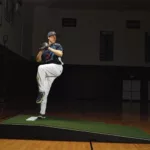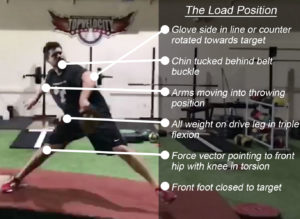Examining every aspect of your pitching mechanics is crucial if you're a pitcher who wants to be the best in the game. The pitching delivery's initial motion is one element that is frequently disregarded. Yet, this first motion sets the tone for the entire throwing sequence and can seriously slow down your pitching velocity if not performed correctly. Even while it looks good, the popular habit of a high leg kick could be the very thing that makes you less effective at pitching. To begin with let's start with a breakdown of the main purpose as to why pitchers lift their leg in the first place.
Understanding the Linear First Move

The essence of a linear first move in pitching is rooted in its simplicity and effectiveness. When a pitcher executes a linear first move, they lift their leg straight up, keeping their body's momentum aligned with their target – the catcher's mitt. This upward motion is more than just a preliminary step; it sets the stage for the entire body to move in a synchronized and directed manner. By lifting the leg straight up, the pitcher can initiate a forward and downward movement that is both efficient and controlled. This straightforward movement ensures that the pitcher's energy is channeled directly towards home plate, minimizing any wasted motion. Moreover, this approach aids in maintaining balance and poise throughout the delivery, which is crucial for consistent pitching mechanics.
Contrasting with the Rotational First Move
On the other hand, a rotational first move presents a stark contrast. This technique involves the pitcher swinging their leg backward towards second base, creating a rotational motion. While this might generate a sense of power, it often leads to a disconnection in the kinetic chain of the pitching motion. As the leg swings back, the pitcher's center of gravity shifts, and this can result in a loss of alignment with the target. The rotational motion might create an initial burst of energy, but this energy is often misdirected, causing inconsistencies in pitch location and reducing overall effectiveness. The rotational first motion also causes players to lead the initial move down the mound with their lift leg. Which kills velocity. For pitchers to generate the maximum amount of force, it is crucial to start the movement down the mound with the hips leading. By properly performing the first move elite athletes can properly load their back leg to
Where the power truly lies

Cody Hall demonstrating the load position
Every pitcher wants to throw with more velocity, right? So, let's focus on the mechanics that will help you maximize every pitch! To do that, pitchers need to understand what is generating the power behind the pitch. Helpful tip, it's not your lift leg. Also, note that I said behind the pitch and not in front. Pitchers do not generate power from in front of them.
As I mentioned previously, the initial move down the mound needs to be with the hips in the lead, not the lift leg. This initial move allows pitchers to stay closed longer, properly load the glute, and align the force vector into a more linear position so they can properly channel all the ground reaction forces they have built efficiently through the kinetic chain. This is why at Top Velocity, I teach my athletes the importance of timing the critical 3X component of the pitching delivery, what I like to call triple extension. Which, if you have read any of my previous articles you will probably already know is the extension of the ankle, knee and hip flexor and is the backbone of the 3X methodology. The reason I insert this here is because when people swing their leg out in front of them, they cut off their ability to properly load and extend the back leg to trigger hip rotation. When the hips don't rotate it forces the arm to overcompensate for the lack of power coming from the leg drive. This is why overuse injuries are so common in baseball. Don't make the same mistakes. Video your mechanics and do your own analysis, and ask yourself, "is your leg kick killing your velocity?" Or send it in for an analysis.
How Newton’s 3rd Law Applies to Mechanics
To get a better understanding of just how this method is backed by science, let's turn to Newton’s 3rd law. “For every reaction there is an equal and opposite reaction,” so if our first movement is the hips leading and the lift leg going back. Eventually, the hips will go back and the lift leg will go forward, which occurs at front foot strike. Which is exactly where we want the movement to occur. However, contrast that with the first move being initiated with the lift leg and instead you have the hips moving forward at front strike and the lift leg going back. That is not how we pitch. That is not going to develop any power pitching mechanics.
How do we fix the issue?
It is a simple fix. However, it will take some getting used to if you have been using a high leg kick for some time, it can be difficult to break the habit. But the benefits of making this slight adjustment to your pitching delivery are extraordinary: reduced stress on the arm, increased velocity, and more command. The list goes on.
The Impact on Pitching Mechanics
The choice between a linear and a rotational first move is more than just a stylistic preference; it fundamentally affects the pitcher's mechanics and effectiveness. A linear move fosters a more streamlined and efficient pitching motion, ensuring that energy is directed towards the plate with minimal loss. This efficiency not only aids in velocity but also in accuracy, as the pitcher's body remains aligned with the target throughout the delivery. In contrast, the rotational move, while potentially feeling more powerful, often leads to a dissipation of energy and a reduction in control. The key for pitchers looking to optimize their performance is to understand these mechanics deeply and choose a style that maximizes their efficiency and effectiveness on the mound. This is where the Top Velocity 3X Velocity Program comes in. This program has helped more athletes fix their pitching mechanics and reach the next level, than any other program. If you are serious about fixing those nagging issues that are holding you back from developing the 90+mph fastball or just reaching the next level.
Getting started with Top Velocity
Getting involved with the top velocity methods is simple. To receive more information, you can either schedule a phone call with us or take the quiz to be contacted by an associate who can put you on your path to a whole new level. Don’t hesitate. Every moment you delay you are leaving gains on the table. Over the years, I have developed a program for every player level, from ages six through infinity, there is a program to help you reach your potential on the mound.
Not a Pitcher? Don't worry. I have you position-players and softball players covered. You can find the links to those programs below.
Other Programs
2x Velocity Camp - for position players
3x Fastpitch Velocity Camp - Softball Players

